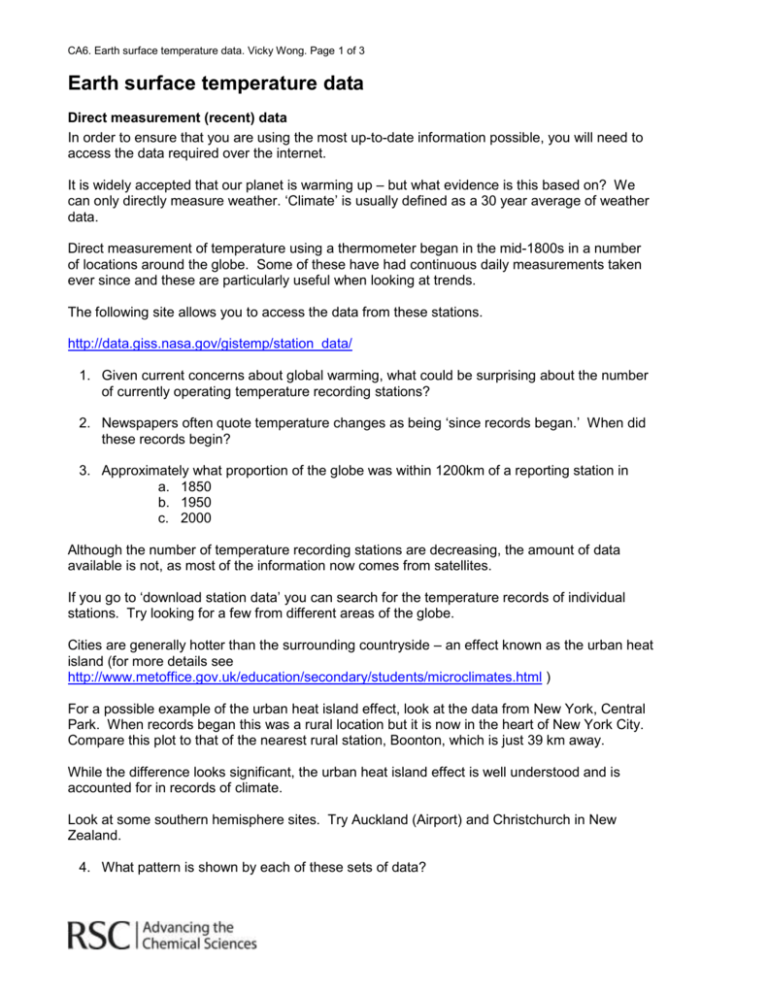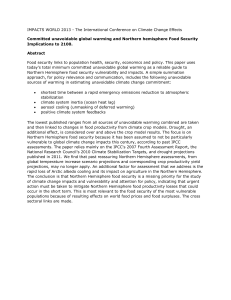Global Warming and Carbon dioxide 2 – recent data
advertisement

CA6. Earth surface temperature data. Vicky Wong. Page 1 of 3 Earth surface temperature data Direct measurement (recent) data In order to ensure that you are using the most up-to-date information possible, you will need to access the data required over the internet. It is widely accepted that our planet is warming up – but what evidence is this based on? We can only directly measure weather. ‘Climate’ is usually defined as a 30 year average of weather data. Direct measurement of temperature using a thermometer began in the mid-1800s in a number of locations around the globe. Some of these have had continuous daily measurements taken ever since and these are particularly useful when looking at trends. The following site allows you to access the data from these stations. http://data.giss.nasa.gov/gistemp/station_data/ 1. Given current concerns about global warming, what could be surprising about the number of currently operating temperature recording stations? 2. Newspapers often quote temperature changes as being ‘since records began.’ When did these records begin? 3. Approximately what proportion of the globe was within 1200km of a reporting station in a. 1850 b. 1950 c. 2000 Although the number of temperature recording stations are decreasing, the amount of data available is not, as most of the information now comes from satellites. If you go to ‘download station data’ you can search for the temperature records of individual stations. Try looking for a few from different areas of the globe. Cities are generally hotter than the surrounding countryside – an effect known as the urban heat island (for more details see http://www.metoffice.gov.uk/education/secondary/students/microclimates.html ) For a possible example of the urban heat island effect, look at the data from New York, Central Park. When records began this was a rural location but it is now in the heart of New York City. Compare this plot to that of the nearest rural station, Boonton, which is just 39 km away. While the difference looks significant, the urban heat island effect is well understood and is accounted for in records of climate. Look at some southern hemisphere sites. Try Auckland (Airport) and Christchurch in New Zealand. 4. What pattern is shown by each of these sets of data? CA6. Earth surface temperature data. Vicky Wong. Page 2 of 3 Even further south is the Scott Base in the Antarctic. Some other southern hemisphere sites in various continents include: Bahia Blanca (South America), Chiang Mai (South East Asia), Bulawayo (Southern Africa). Look at at least one these. 5. From the southern hemisphere sites mentioned, what can you conclude about temperature changes there? This is a only a small set of the available data. To see a fuller picture of temperature change in the southern hemisphere go to the UK met office climate indicators page: http://www.metoffice.gov.uk/research/hadleycentre/obsdata/climateindicators.html#GlobHem Find graphs showing temperatures in each hemisphere. 6. How do the changes in the southern hemisphere compare to those in the northern hemisphere? 7. What is the danger of using a small number of data sets to draw a conclusion (as in Q6 above)? Part of the same site includes global average temperature plots: http://www.metoffice.gov.uk/research/hadleycentre/obsdata/HadCRUGNS.html Look at the graphs for annual global temperatures and monthly anomolies. 8. What is the general global temperature trend from a 1900-1940? b 1940-1950? c 1990-2006? Since 1659, temperature measurements in England have been amalgamated to form the 'Central England Temperature record' or CET. This is an incredibly valuable resource because of its length. From 1659 through to about 1700 is the end of a period known as the ‘little ice age’ in Europe. There is no direct data prior to 1659, but there are stories of the Thames freezing over and temperature proxies (data which can be studied to infer what the temperature was like) such as tree ring width show that it was much colder than it is now. CA6. Earth surface temperature data. Vicky Wong. Page 3 of 3 Graph courtesy of Wilson Flood. Adapted from Crown Copyright data supplied by the Met Office. 9. What do you notice about the period from 1695 to 1733, marked in red on the graph above? You can see a similar graph of data up to the present on http://hadobs.metoffice.com/hadcet/. 10. Is there a pattern of warming from around 1800 through to the mid 1900s (when carbon dioxide levels were on the increase)? 11. From 1986 through to 2000 what happened to the temperature? Taking direct temperature measurements together with satellite data and other observations it is possible to say that the temperature of the earth is definitely increasing. Eleven of the last 12 years (1995-2006) rank among the 12 warmest years in records of global surface temperature since 1850. This data on its own does not tell us why there is an increase – just that one can be observed. This temperature information is important as climate scientists analyse weather observations for changes in patterns with time and also need reliable observations to allow them to build computer models of the climate. These models allow them to try to predict what might happen in the future. If a model cannot accurately reproduce key aspects of past climate, its simulations of the future are of limited value. The observations are also crucial for initialising model simulations; at the start of a simulation, a model must have an accurate picture of current weather if it is to accurately predict how those patterns will evolve over the coming days and years.









